Chapter: Security in Computing : Elementary Cryptography
The Uses of Encryption
The Uses of Encryption
Encryption algorithms alone
are not the answer to everyone's encryption needs. Although encryption
implements protected communications channels, it can also be used for other
duties. In fact, combining symmetric and asymmetric encryption often
capitalizes on the best features of each.
Public key algorithms are
useful only for specialized tasks because they are very slow. A public key
encryption can take 10,000 times as long to perform as a symmetric encryption
because the underlying modular exponentiation depends on multiplication and
division, which are inherently slower than the bit operations (addition,
exclusive OR, substitution, and shifting) on which symmetric algorithms are
based. For this reason, symmetric encryption is the cryptographers'
"workhorse," and public key encryption is reserved for specialized,
infrequent uses, where slow operation is not a continuing problem.
Let us look more closely at
four applications of encryption: cryptographic hash functions, key exchange,
digital signatures, and certificates.
Cryptographic Hash Functions
Encryption is most commonly
used for secrecy; we usually encrypt something so that its contentsor even its
existenceare unknown to all but a privileged audience. In some cases, however,
integrity is a more important concern than secrecy. For example, in a document
retrieval system containing legal records, it may be important to know that the
copy retrieved is exactly what was stored. Likewise, in a secure communications
system, the need for the correct transmission of messages may override secrecy
concerns. Let us look at how encryption provides integrity.
In most files, the elements
or components of the file are not bound together in any way. That is, each byte
or bit or character is independent of every other one in the file. This lack of
binding means that changing one value affects the integrity of the file, but
that one change can easily go undetected.
What we would like to do is somehow put a seal
or shield around the file so that we can detect when the seal has been broken
and thus know that something has been changed. This notion is similar to the
use of wax seals on letters in medieval days; if the wax was broken, the
recipient would know that someone had broken the seal and read the message
inside. In the same way, cryptography can be used to seal a file, encasing it
so that any change becomes apparent. One technique for providing the seal is to
compute a cryptographic function, sometimes called a hash or checksum or message digest of the file.

A one-way function can be
useful in an encryption algorithm. The function must depend on all bits of the
file being sealed, so any change to even a single bit will alter the checksum
result. The checksum value is stored with the file. Then, each time the file is
accessed or used, the checksum is recomputed. If the computed checksum matches
the stored value, it is likely that the file has not been changed.
A cryptographic function,
such as the DES or AES, is especially appropriate for sealing values, since an
outsider will not know the key and thus will not be able to modify the stored
value to match with data being modified. For low-threat applications,
algorithms even simpler than DES or AES can be used. In block encryption
schemes, chaining means linking each
block to the previous block's value (and therefore to all previous blocks), for
example, by using an exclusive OR to combine the encrypted previous block with
the encryption of the current one. A file's cryptographic checksum could be the
last block of the chained encryption of a file since that block will depend on
all other blocks.
As we see later in this
chapter, these techniques address the nonalterability and nonreusability
required in a digital signature. A change or reuse will be flagged by the
checksum, so the recipient can tell that something is amiss.
The most widely used cryptographic hash
functions are MD4, MD5 (where MD
stands for Message Digest), and SHA/SHS
(Secure Hash Algorithm or Standard). The MD4/5 algorithms were invented by Ron
Rivest and RSA Laboratories. MD5 is an improved version of MD4. Both condense a
message of any size to a 128-bit digest. SHA/SHS is similar to both MD4 and
MD5; it produces a 160-bit digest.
Wang et al. [WAN05] have announced cryptanalysis attacks on
SHA, MD4, and MD5. For SHA, the attack is able to find two plaintexts
that produce the same hash
digest in approximately 263 steps, far short of the 2 80 steps that would be expected of a 160-bit hash
function, and very feasible for a moderately well-financed attacker. Although
this attack does not mean SHA is useless (the attacker must collect and analyze
a large number of ciphertext samples), it does suggest use of long digests and
long keys. NIST [NIS05, NIS06] has studied the attack carefully and
recommended countermeasures.
Key Exchange
Suppose you need to send a
protected message to someone you do not know and who does not know you. This
situation is more common than you may think. For instance, you may want to send
your income tax return to the government. You want the information to be
protected, but you do not necessarily know the person who is receiving the
information. Similarly, you may want to use your web browser to connect with a
shopping web site, exchange private (encrypted) e-mail, or arrange for two
hosts to establish a protected channel. Each of these situations depends on
being able to exchange an encryption key in such a way that nobody else can
intercept it. The problem of two previously unknown parties exchanging
cryptographic keys is both hard and important. Indeed, the problem is almost
circular: To establish an encrypted session, you need an encrypted means to
exchange keys.
Public key cryptography can help. Since
asymmetric keys come in pairs, one half of the pair can be exposed without
compromising the other half. To see how, suppose S and R (our well-known sender
and receiver) want to derive a shared symmetric key. Suppose also that S and R
both have public keys for a common encryption algorithm; call these kPRIV
-S, kPUB-S, kPRIV -R, and kPUB -R, for
the private and public keys for S and R, respectively. The simplest solution is
for S to choose any symmetric key K, and send E(kPRIV-S,K) to R.
Then, R takes S's public key, removes the encryption, and obtains K. Alas, any
eavesdropper who can get S's public key can also obtain K.
Instead, let S send E(kPUB-R, K) to
R. Then, only R can decrypt K. Unfortunately, R has no assurance that K came
from S.
But there is a useful alternative. The solution
is for S to send to R:
E(kPUB-R, E(kPRIV-S, K))
We can think of this exchange in terms of lockboxes and keys. If S
wants to send something protected to R (such as a credit card number or a set
of medical records), then the exchange works something like this. S puts the
protected information in a lockbox that can be opened only with S's public key.
Then, that lockbox is put inside a second lockbox that can be opened only with
R's private key. R can then use his private key to open the outer box (something
only he can do) and use S's public key to open the inner box (proving that the
package came from S). In other words, the protocol wraps the protected
information in two packages: the first unwrapped only with S's public key, and
the second unwrapped only with R's private key. This approach is illustrated in
Figure 2-11.
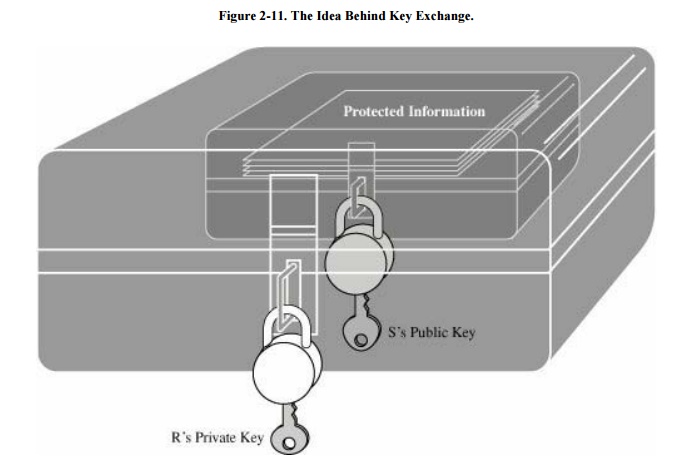
Another approach not requiring pre-shared
public keys is the so-called DiffieHellman key exchange protocol. In this
protocol, S and R use some simple arithmetic to exchange a secret. They agree
on a field size n and a starting number g; they can communicate these numbers
in
the clear. Each thinks up a secret number, say,
s and r. S sends to R gs and R sends to S gr. Then S
computes (gr)s and R computes (gs)r,
which are the same, so grs = gsr
becomes their shared secret. (One technical detail has been omitted for
simplicity: these computations are done over a field of integers mod n; see Chapter 12 for more information on modular
arithmetic.)
Digital Signatures
Another typical situation
parallels a common human need: an order to transfer funds from one person to
another. In other words, we want to be able to send electronically the
equivalent of a computerized check. We understand how this transaction is
handled in the conventional, paper mode:
·
A check is a tangible object authorizing a financial transaction.
·
The signature on the check confirms authenticity because
(presumably) only the legitimate signer can produce that signature.
·
In the case of an alleged forgery, a third party can be called in
to judge authenticity.
·
Once a check is cashed, it is canceled so that it cannot be reused.
·
The paper check is not alterable. Or, most forms of alteration are
easily detected.
Transacting business by check
depends on tangible objects in a prescribed form. But tangible objects do not
exist for transactions on computers. Therefore, authorizing payments by
computer requires a different model. Let us consider the requirements of such a
situation, both from the standpoint of a bank and from the standpoint of a
user.
Suppose Sandy sends her bank
a message authorizing it to transfer $100 to Tim. Sandy's bank must be able to
verify and prove that the message really came from Sandy if she should later
disavow sending the message. The bank also wants to know that the message is
entirely Sandy's, that it has not been altered along the way. On her part,
Sandy wants to be certain that her bank cannot forge such messages. Both
parties want to be sure that the message is new, not a reuse of a previous
message, and that it has not been altered during transmission. Using electronic
signals instead of paper complicates this process.
But we have ways to make the
process work. A digital signature is
a protocol that produces the same effect as a real signature: It is a mark that
only the sender can make, but other people can easily recognize as belonging to
the sender. Just like a real signature, a digital signature is used to confirm
agreement to a message.
Properties
A digital signature must meet
two primary conditions:
·
It must be unforgeable. If person P signs message M with signature
S(P,M), it is impossible for anyone else to produce the pair [M, S(P,M)].
·
It must be authentic. If a person R receives the pair [M, S(P,M)]
purportedly from P, R can check that the signature is really from P. Only P
could have created this signature, and the signature is firmly attached to M.
These two requirements, shown
in Figure 2-12, are the major hurdles in
computer transactions. Two more properties, also drawn from parallels with the
paper-based environment, are desirable for transactions completed with the aid
of digital signatures:
·
It is not alterable. After being transmitted, M cannot be changed
by S, R, or an interceptor.
·
It is not reusable. A previous message presented again will be
instantly detected by R.
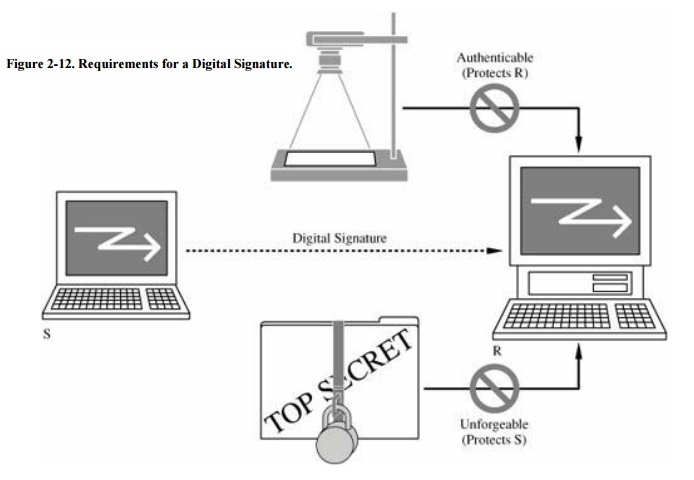
To see how digital signatures
work, we first present a mechanism that meets the first two requirements. We
then add to that solution to satisfy the other requirements.
Public Key Protocol
Public key encryption systems are ideally
suited to digital signatures. For simple notation, let us assume that the
public key encryption for user U is accessed through E(M, KU) and
that the private key transformation for U is written as D(M,KU). We
can think of E as the privacy transformation (since only U can decrypt it) and
D as the authenticity transformation (since only U can produce it). Remember,
however, that under some asymmetric algorithms such as RSA, D and E are
commutative, and either one can be applied to any message. Thus,
D(E(M, ), ) = M = E(D(M, ), )
If S wishes to send M to R, S uses the
authenticity transformation to produce D(M, KS). S then sends D(M, KS)
to R. R decodes the message with the public key transformation of S, computing
E(D(M,KS), KS) = M. Since only S can create a message
that makes sense under E(,KS), the message must genuinely have come
from S. This test satisfies the authenticity requirement.
R will save D(M,KS). If S should
later allege that the message is a forgery (not really from S), R can simply
show M and D(M,KS). Anyone can verify that since D(M,KS)
is transformed to M with the public key transformation of Sbut only S could
have produced D (M,KS)then D(M,KS) must be from S. This test
satisfies the unforgeable requirement.
There are other approaches to implementing
digital signature; some use symmetric encryption, others use asymmetric. The
approach shown here illustrates how the protocol can address the requirements
for unforgeability and authenticity. To add secrecy, S applies E(M, KR)
as shown in Figure 2-13.
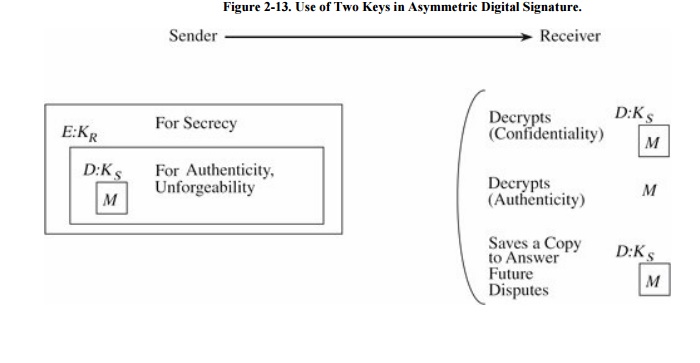
Next, we learn about cryptographic certificates
so that we can see how they are used to address authenticity.
Certificates
As humans we establish trust
all the time in our daily interactions with people. We identify people we know
by recognizing their voices, faces, or handwriting. At other times, we use an
affiliation to convey trust. For instance, if a stranger telephones us and we
hear, "I represent the local government…" or "I am calling on
behalf of this charity…" or "I am calling from the
school/hospital/police about your
mother/father/son/daughter/brother/sister…," we may decide to trust the
caller even if we do not know him or her. Depending on the nature of the call,
we may decide to believe the caller's affiliation or to seek independent
verification. For example, we may obtain the affiliation's number from the
telephone directory and call the party back. Or we may seek additional
information from the caller, such as "What color jacket was she
wearing?" or "Who is the president of your organization?" If we
have a low degree of trust, we may even act to exclude an outsider, as in
"I will mail a check directly to your charity rather than give you my
credit card number."
For each of these
interactions, we have what we might call a "trust threshold," a
degree to which we are willing to believe an unidentified individual. This
threshold exists in commercial interactions, too. When Acorn Manufacturing
Company sends Big Steel Company an order for 10,000 sheets of steel, to be
shipped within a week and paid for within ten days, trust abounds. The order is
printed on an Acorn form, signed by someone identified as Helene Smudge,
Purchasing Agent. Big Steel may begin preparing the steel even before receiving
money from Acorn. Big Steel may check Acorn's credit rating to decide whether
to ship the order without payment first. If suspicious, Big Steel might
telephone Acorn and ask to speak to Ms. Smudge in the purchasing department.
But more likely Big Steel will actually ship the goods without knowing who Ms.
Smudge is, whether she is actually the purchasing agent, whether she is
authorized to commit to an order of that size, or even whether the signature is
actually hers. Sometimes a transaction like this occurs by fax, so that Big
Steel does not even have an original signature on file. In cases like this one,
which occur daily, trust is based on appearance of authenticity (such as a
printed, signed form), outside information (such as a credit report), and
urgency (Acorn's request that the steel be shipped quickly).
For electronic communication
to succeed, we must develop similar ways for two parties to establish trust
without having met. A common thread in our personal and business interactions
is the ability to have someone or something vouch for the existence and
integrity of one or both parties. The police, the Chamber of Commerce, or the
Better Business Bureau vouches for the authenticity of a caller. Acorn
indirectly vouches for the fact that Ms. Smudge is its purchasing agent by
transferring the call to her in the purchasing department. In a sense, the
telephone company vouches for the authenticity of a party by listing it in the
directory. This concept of "vouching for" by a third party can be a
basis for trust in commercial settings where two parties do not know each
other.
Trust Through a Common Respected Individual
A large company may have
several divisions, each division may have several departments, each department
may have several projects, and each project may have several task groups (with
variations in the names, the number of levels, and the degree of completeness
of the hierarchy). The top executive may not know by name or sight every employee
in the company, but a task group leader knows all members of the task group,
the project leader knows all task group leaders, and so on. This hierarchy can
become the basis for trust throughout the organization.
To see how, suppose two
people meet: Ann and Andrew. Andrew says he works for the same company as Ann.
Ann wants independent verification that he does. She finds out that Bill and
Betty are two task group leaders for the same project (led by Camilla); Ann
works for Bill and Andrew for Betty. (The organizational relationships are
shown in Figure 2-14.) These facts give
Ann and Andrew a basis for trusting each other's identity. The chain of
verification might be something like this:
·
Ann asks Bill who Andrew is.
·
Bill either asks Betty if he knows her directly or if not, asks
Camilla.
·
Camilla asks Betty.
·
Betty replies that Andrew works for her.
·
Camilla tells Bill.
·
Bill tells Ann.
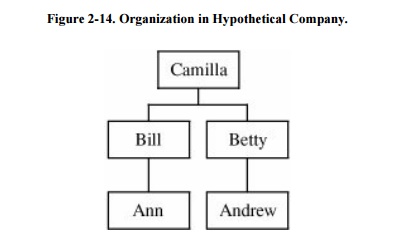
If Andrew is in a different task
group, it may be necessary to go higher in the organizational tree before a
common point is found.
We can use a similar process for cryptographic
key exchange, as shown in Figure 2-15.
If Andrew and Ann want to communicate, Andrew can give his public key to Betty,
who passes it to Camilla or directly to Bill, who gives it to Ann. But this
sequence is not exactly the way it would work in real life. The key would
probably be accompanied by a note saying it is from Andrew, ranging from a bit
of yellow paper to a form 947 Statement of Identity. And if a form 947 is used,
then Betty would also have to attach a form 632a Transmittal of Identity,
Camilla would attach another 632a, and Bill would attach a final one, as shown
in Figure 2-15. This chain of 632a forms
would say, in essence, "I am Betty and I received this key and the
attached statement of identity personally from a person I know to be
Andrew," "I am Camilla and I received this key and the attached
statement of identity and the attached transmittal of identity personally from
a person I know to be Betty," and so forth. When Ann receives the key, she
can review the chain of evidence and conclude with reasonable assurance that
the key really did come from Andrew. This protocol is a way of obtaining authenticated
public keys, a binding of a key, and a reliable identity.
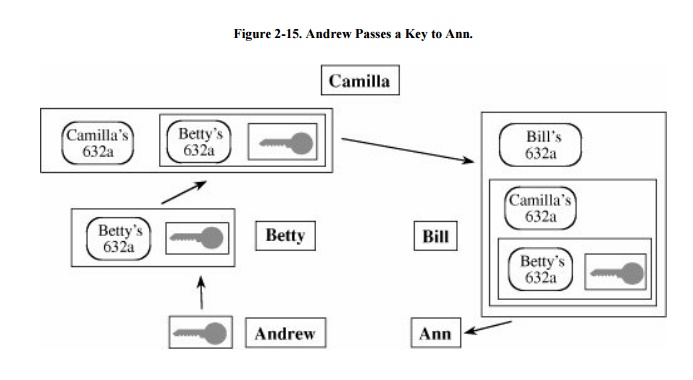
This model works well within a company because
there is always someone common to any two employees, even if the two employees
are in different divisions so that the common person is the president. The
process bogs down, however, if Ann, Bill, Camilla, Betty, and Andrew all have
to be available whenever Ann and Andrew want to communicate. If Betty is away
on a business trip or Bill is off sick, the protocol falters. It also does not
work well if the president cannot get any meaningful work done because every
day is occupied with handling forms 632a.
To address the first of these
problems, Andrew can ask for his complete chain of forms 632a from the
president down to him. Andrew can then give a copy of this full set to anyone
in the company who wants his key. Instead of working from the bottom up to a
common point, Andrew starts at the top and derives his full chain. He gets
these signatures any time his superiors are available, so they do not need to
be available when he wants to give away his authenticated public key.
The second problem is resolved by reversing the
process. Instead of starting at the bottom (with task members) and working to
the top of the tree (the president), we start at the top. Andrew thus has a
preauthenticated public key for unlimited use in the future. Suppose the
expanded structure of our hypothetical company, showing the president and other
levels, is as illustrated in Figure 2-16.
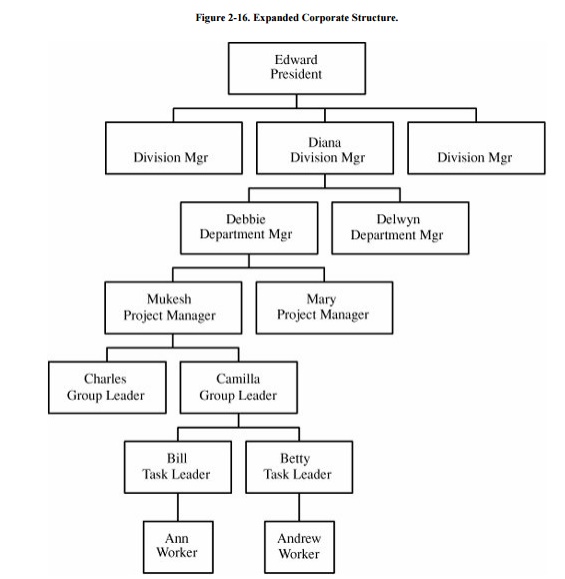
The president creates a
letter for each division manager saying "I am Edward, the president, I
attest to the identity of division manager Diana, whom I know personally, and I
trust Diana to attest to the identities of her subordinates." Each division
manager does similarly, copying the president's letter with each letter the
manager creates, and so on. Andrew receives a packet of letters, from the
president down through his task group leader, each letter linked by name to the
next. If every employee in the company receives such a packet, any two
employees who want to exchange authenticated keys need only compare each
other's packets; both packets will have at least Edward in common, perhaps some
other high managers, and at some point will deviate. Andrew and Ann, for
example, could compare their chains, determine that they were the same through
Camilla, and trace the bottom parts. Andrew knows Alice's chain is authentic
through Camilla because it is identical to his chain, and Ann knows the same.
Each knows the rest of the chain is accurate because it follows an unbroken
line of names and signatures.
Certificates to Authenticate an Identity
This protocol is represented
more easily electronically than on paper. With paper, it is necessary to guard
against forgeries, to prevent part of one chain from being replaced and to
ensure that the public key at the bottom is bound to the chain. Electronically
the whole thing can be done with digital signatures and hash functions.
Kohnfelder seems to be the
originator of the concept of using an electronic certificate with a chain of
authenticators, which is expanded in Merkle's paper .
A public key and user's
identity are bound together in a certificate,
which is then signed by someone called a certificate
authority, certifying the accuracy of the binding. In our example, the
company might set up a certificate scheme in the following way. First, Edward
selects a public key pair, posts the public part where everyone in the company
can retrieve it, and retains the private part. Then, each division manager,
such as Diana, creates her public key pair, puts the public key in a message
together with her identity, and passes the message securely to Edward. Edward
signs it by creating a hash value of the message and then encrypting the
message and the hash with his private key. By signing the message, Edward
affirms that the public key (Diana's) and the identity (also Diana's) in the
message are for the same person. This message is called Diana's certificate.
All of Diana's department managers create
messages with their public keys, Diana signs and hashes each, and returns them.
She also appends to each a copy of the certificate she received from Edward. In
this way, anyone can verify a manager's certificate by starting with Edward's
well-known public key, decrypting Diana's certificate to retrieve her public
key (and identity), and using Diana's public key to decrypt the manager's
certificate. Figure 2-17 shows how
certificates are created for Diana and one of her managers, Delwyn. This
process continues down the hierarchy to Ann and Andrew. As shown in Figure 2-18, Andrew's certificate is really his
individual certificate combined with all certificates for those above him in
the line to the president.
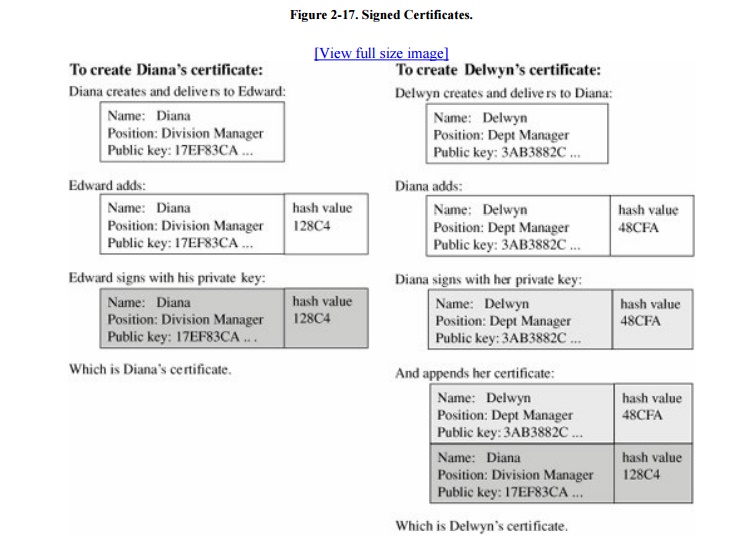
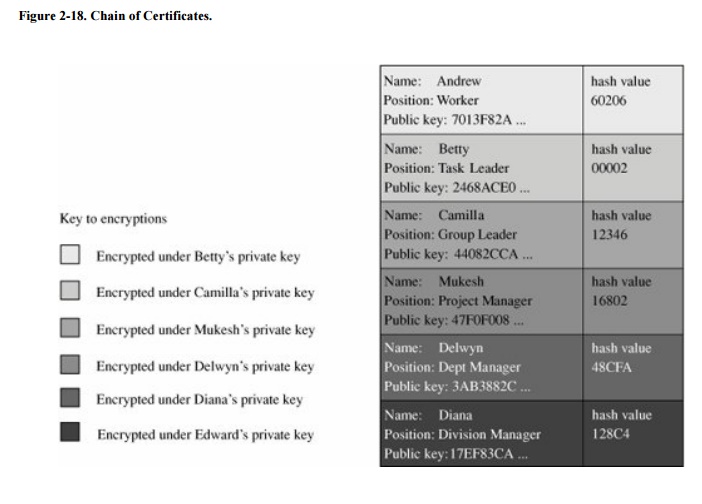
Trust Without a Single Hierarchy
In our examples, certificates were issued on
the basis of the managerial structure. But it is not necessary to have such a
structure or to follow it to use certificate signing for authentication. Anyone
who is considered acceptable as an authority can sign a certificate. For
example, if you want to determine whether a person received a degree from a
university, you would not contact the president or chancellor but would instead
go to the office of records or the registrar. To verify someone's employment,
you might ask the personnel office or the director of human resources. And to
check if someone lives at a particular address, you might consult the office of
public records.
Sometimes, a particular person is designated to
attest to the authenticity or validity of a document or person. For example, a
notary public attests to the validity of a (written) signature on a document.
Some companies have a security officer to verify that an employee has
appropriate security clearances to read a document or attend a meeting. Many
companies have a separate personnel office for each site or each plant
location; the personnel officer vouches for the employment status of the
employees at that site. Any of these officers or heads of offices could
credibly sign certificates for people under their purview. Natural hierarchies
exist in society, and these same hierarchies can be used to validate
certificates.
The only problem with a hierarchy is the need
for trust at the top level. The entire chain of authenticity is secure because
each certificate contains the key that decrypts the next certificate, except
for the top. Within a company, it is reasonable to trust the person at the top.
But if certificates are to become widely used in electronic commerce, people
must be able to exchange certificates securely across companies, organizations,
and countries.
The Internet is a large federation of networks
for intercompany, interorganizational, and international (as well as
intracompany, intraorganizational, and intranational) communication. It is not
a part of any government, nor is it a privately owned company. It is governed
by a board called the Internet Society. The Internet Society has power only
because its members, the governments and companies that together make up the
Internet, agree to work together. But there really is no "top" for
the Internet. Different companies, such as C&W HKT, SecureNet, Verisign,
Baltimore Technologies, Deutsche Telecom, Societá Interbancaria per l'Automatzione
di Milano, Entrust, and Certiposte are root certification authorities, which
means each is a highest authority that signs certificates. So, instead of one
root and one top, there are many roots, largely structured around national
boundaries.
In this chapter, we introduced several
approaches to key distribution, ranging from direct exchange to distribution
through a central distribution facility to certified advance distribution. We
explore the notions of certificates and certificate authorities in more depth
in Chapter 7,
in which we discuss Public Key Infrastructures. But no matter what approach is
taken to key distribution, each has its advantages and disadvantages. Points to keep in mind about
any key distribution protocol include the following:
· What operational restrictions are there? For
example, does the protocol require a continuously available facility, such as
the key distribution center?
·
What trust requirements are there? Who and what entities must be
trusted to act properly?
·
What is the protection against failure? Can an outsider impersonate
any of the entities in the protocol and subvert security? Can any party of the
protocol cheat without detection?
·
How efficient is the protocol? A protocol requiring several steps
to establish an encryption key that will be used many times is one thing; it is
quite another to go through several time-consuming steps for a one-time use.
·
How easy is the protocol to implement? Notice that complexity in
computer implementation may be different from manual use.
The descriptions of the protocols have raised
some of these issues; others are brought out in the exercises at the end of
this chapter.
Related Topics